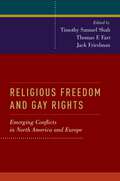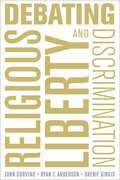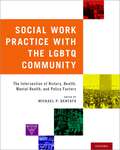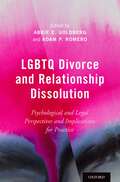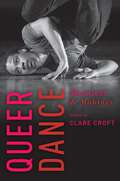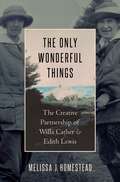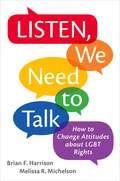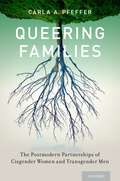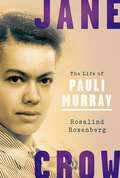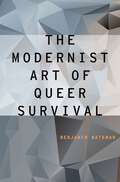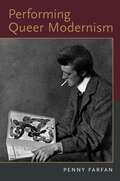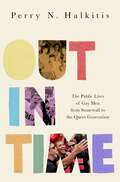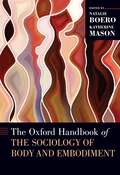- Table View
- List View
Religious Freedom and Gay Rights: Emerging Conflicts in the United States and Europe
by Jack FriedmanIn the United States and Europe, an increasing emphasis on equality has pitted rights claims against each other, raising profound philosophical, moral, legal, and political questions about the meaning and reach of religious liberty. Nowhere has this conflict been more salient than in the debate between claims of religious freedom, on one hand, and equal rights claims made on the behalf of members of the lesbian, gay, bisexual, and transgender (LGBT) community, on the other. As new rights for LGBT individuals have expanded in liberal democracies across the West, longstanding rights of religious freedom -- such as the rights of religious communities to adhere to their fundamental teachings, including protecting the rights of conscience; the rights of parents to impart their religious beliefs to their children; and the liberty to advance religiously-based moral arguments as a rationale for laws -- have suffered a corresponding decline. Timothy Samuel Shah, Thomas F. Farr, and Jack Friedman's volume, Religious Freedom and Gay Rights brings together some of the world's leading thinkers on religion, morality, politics, and law to analyze the emerging tensions between religious freedom and gay rights in three key geographic regions: the United States, the United Kingdom, and continental Europe. What implications will expanding regimes of equality rights for LGBT individuals have on religious freedom in these regions? What are the legal and moral frameworks that govern tensions between gay rights and religious freedom? How are these tensions illustrated in particular legal, political, and policy controversies? And what is the proper way to balance new claims of equality against existing claims for freedom of religious groups and individuals? Religious Freedom and Gay Rights offers several explorations of these questions.
Debating Religious Liberty and Discrimination
by John Corvino Ryan T. Anderson Sherif GirgisVirtually everyone supports religious liberty, and virtually everyone opposes discrimination. But how do we handle the hard questions that arise when exercises of religious liberty seem to discriminate unjustly? How do we promote the common good while respecting conscience in a diverse society? This point-counterpoint book brings together leading voices in the culture wars to debate such questions: John Corvino, a longtime LGBT-rights advocate, opposite Ryan T. Anderson and Sherif Girgis, prominent young social conservatives. Many such questions have arisen in response to same-sex marriage: How should we treat county clerks who do not wish to authorize such marriages, for example; or bakers, florists, and photographers who do not wish to provide same-sex wedding services? But the conflicts extend well beyond the LGBT rights arena. How should we treat hospitals, schools, and adoption agencies that can't in conscience follow antidiscrimination laws, healthcare mandates, and other regulations? Should corporations ever get exemptions? Should public officials? Should we keep controversial laws like the Religious Freedom Restoration Act, or pass new ones like the First Amendment Defense Act? Should the law give religion and conscience special protection at all, and if so, why? What counts as discrimination, and when is it unjust? What kinds of material and dignitary harms should the law try to fight-and what is dignitary harm, anyway? Beyond the law, how should we treat religious beliefs and practices we find mistaken or even oppressive? Should we tolerate them or actively discourage them? In point-counterpoint format, Corvino, Anderson and Girgis explore these questions and more. Although their differences run deep, they tackle them with civility, clarity, and flair. Their debate is an essential contribution to contemporary discussions about why religious liberty matters and what respecting it requires.
DEBATING RELIGIOUS LIBERTY & DISCRIMIN C
by Sherif Girgis Ryan T. Anderson John CorvinoVirtually everyone supports religious liberty, and virtually everyone opposes discrimination. But how do we handle the hard questions that arise when exercises of religious liberty seem to discriminate unjustly? How do we promote the common good while respecting conscience in a diverse society? This point-counterpoint book brings together leading voices in the culture wars to debate such questions: John Corvino, a longtime LGBT-rights advocate, opposite Ryan T. Anderson and Sherif Girgis, prominent young social conservatives. Many such questions have arisen in response to same-sex marriage: How should we treat county clerks who do not wish to authorize such marriages, for example; or bakers, florists, and photographers who do not wish to provide same-sex wedding services? But the conflicts extend well beyond the LGBT rights arena. How should we treat hospitals, schools, and adoption agencies that can't in conscience follow antidiscrimination laws, healthcare mandates, and other regulations? Should corporations ever get exemptions? Should public officials? Should we keep controversial laws like the Religious Freedom Restoration Act, or pass new ones like the First Amendment Defense Act? Should the law give religion and conscience special protection at all, and if so, why? What counts as discrimination, and when is it unjust? What kinds of material and dignitary harms should the law try to fight-and what is dignitary harm, anyway? Beyond the law, how should we treat religious beliefs and practices we find mistaken or even oppressive? Should we tolerate them or actively discourage them? In point-counterpoint format, Corvino, Anderson and Girgis explore these questions and more. Although their differences run deep, they tackle them with civility, clarity, and flair. Their debate is an essential contribution to contemporary discussions about why religious liberty matters and what respecting it requires.
RELIGIOUS FREEDOM & GAY RIGHTS C: Emerging Conflicts in the United States and Europe
by Jack FriedmanIn the United States and Europe, an increasing emphasis on equality has pitted rights claims against each other, raising profound philosophical, moral, legal, and political questions about the meaning and reach of religious liberty. Nowhere has this conflict been more salient than in the debate between claims of religious freedom, on one hand, and equal rights claims made on the behalf of members of the lesbian, gay, bisexual, and transgender (LGBT) community, on the other. As new rights for LGBT individuals have expanded in liberal democracies across the West, longstanding rights of religious freedom -- such as the rights of religious communities to adhere to their fundamental teachings, including protecting the rights of conscience; the rights of parents to impart their religious beliefs to their children; and the liberty to advance religiously-based moral arguments as a rationale for laws -- have suffered a corresponding decline. Timothy Samuel Shah, Thomas F. Farr, and Jack Friedman's volume, Religious Freedom and Gay Rights brings together some of the world's leading thinkers on religion, morality, politics, and law to analyze the emerging tensions between religious freedom and gay rights in three key geographic regions: the United States, the United Kingdom, and continental Europe. What implications will expanding regimes of equality rights for LGBT individuals have on religious freedom in these regions? What are the legal and moral frameworks that govern tensions between gay rights and religious freedom? How are these tensions illustrated in particular legal, political, and policy controversies? And what is the proper way to balance new claims of equality against existing claims for freedom of religious groups and individuals? Religious Freedom and Gay Rights offers several explorations of these questions.
Social Work Practice with the LGBTQ Community: The Intersection of History, Health, Mental Health, and Policy Factors
Social Work Practice with the LGBTQ Community aims to weave together the realms of sociopolitical, historical, and policy contexts in order to assist readers with understanding the base for effective and affirming health and mental health practice with diverse members of the LGBTQ community. Comprised of chapters written by social work academics and their allies -- whose combined knowledge in the field spans decades of direct experience in human behavior, practice, policy, and research -- this book features applicable and useful content for social work students and practitioners across the allied health and mental health professions, as well as across disciplines. The expansive practice text examines international concerns and content associated with the LGBTQ movement and ongoing needs related to health, mental health, policy and advocacy, among other areas of concern. Specific highlights of the chapters include narrative that blends conceptual, theoretical, and empirical content; examination of current trends in the field related to practice considerations and intersectionality; and snapshots of concerns related to international progress and ongoing challenges related to equality and policy. Additionally, as a classroom support for instructors, each chapter has a corresponding power point presentation which includes a resource list pertaining to that chapter's focus with websites, film, and video links as well as national and international organizations associated with the LGBTQ community. Overall, Social Work Practice with the LGBTQ Community is an invaluable resource for graduate students within social work programs and related disciplines, academics, and health/mental health practitioners currently in the field.
Social Work Practice with the LGBTQ Community: The Intersection of History, Health, Mental Health, and Policy Factors
by Michael P. DentatoSocial Work Practice with the LGBTQ Community aims to weave together the realms of sociopolitical, historical, and policy contexts in order to assist readers with understanding the base for effective and affirming health and mental health practice with diverse members of the LGBTQ community. Comprised of chapters written by social work academics and their allies -- whose combined knowledge in the field spans decades of direct experience in human behavior, practice, policy, and research -- this book features applicable and useful content for social work students and practitioners across the allied health and mental health professions, as well as across disciplines. The expansive practice text examines international concerns and content associated with the LGBTQ movement and ongoing needs related to health, mental health, policy and advocacy, among other areas of concern. Specific highlights of the chapters include narrative that blends conceptual, theoretical, and empirical content; examination of current trends in the field related to practice considerations and intersectionality; and snapshots of concerns related to international progress and ongoing challenges related to equality and policy. Additionally, as a classroom support for instructors, each chapter has a corresponding power point presentation which includes a resource list pertaining to that chapter's focus with websites, film, and video links as well as national and international organizations associated with the LGBTQ community. Overall, Social Work Practice with the LGBTQ Community is an invaluable resource for graduate students within social work programs and related disciplines, academics, and health/mental health practitioners currently in the field.
LGBTQ Divorce and Relationship Dissolution: Psychological and Legal Perspectives and Implications for Practice
What unique challenges face LGBTQ individuals in relationships or who are separating or divorcing, especially now that same-sex couples may marry? What issues might complicate the ending of relationships when children, multiple partners, or multiple parents are present? How do gender, gender transition, ethnicity, immigration status, economic status, geography, and other characteristics shape the experiences of divorcing or separating LGBTQ people? Finally, how can therapists and lawyers most effectively assist LGBTQ people whose relationships and families are dissolving? LGBTQ Divorce and Relationship Dissolution: Psychological and Legal Perspectives and Implications for Practice brings together social science and legal perspectives to examine the timely topic of relationship dissolution and divorce among sexual and gender minorities. The first edited book to tackle this topic in an informed, comprehensive, and interdisciplinary matter, this volume gathers and expands current knowledge on topics such as LGBTQ people's relationship and dissolution patterns; the divorce and child custody rules and processes that now apply to many LGBTQ families; and the surrounding political and cultural environment in the United States. It will also address practical issues such as mediation with same-sex couples who are separating or divorcing, financial planning, and family therapy for sexual minority parents and their children in the context of divorce/dissolution. With chapters contributed by leading scholars and practitioners from law, political science, psychology, sociology, and other disciplines, LGBTQ Divorce and Relationship Dissolution will be an invaluable resource for academics, practitioners, policymakers, and LGBTQ people. It will also be of interest to students in psychology, counseling, law, and LGBTQ and gender studies.
QUEER DANCE C
by Clare CroftIf we imagine multiple ways of being together, how might that shift choreographic practices and help us imagine ways groups assemble in more varied ways than just pairing another man with another woman? How might dancing queerly ask us to imagine futures through something other than heterosexuality and reproduction? How does challenging gender binaries always mean thinking about race, thinking about the postcolonial, about ableism? What are the arbitrary rules structuring dance in all its arenas, whether concert and social or commercial and competition, and how do we see those invisible structures and work to disrupt them? Queer Dance brings together artists and scholars in a multi-platformed project-book, accompanying website, and live performance series to ask, "How does dancing queerly progressively challenge us?" The artists and scholars whose writing appears in the book and whose performances and filmed interviews appear online stage a range of genders and sexualities that challenge and destabilize social norms. Engaging with dance making, dance scholarship, queer studies, and other fields, Queer Dance asks how identities, communities, and artmaking and scholarly practices might consider what queer work the body does and can do. There is great power in claiming queerness in the press of bodies touching or in the exceeding of the body best measured in sweat and exhaustion. How does queerness exist in the realm of affect and touch, and what then might we explore about queerness through these pleasurable and complex bodily ways of knowing?
The Only Wonderful Things: The Creative Partnership of Willa Cather & Edith Lewis
by Melissa J. HomesteadA groundbreaking new look at American novelist Willa Cather's creative process What would Willa Cather's widely read and cherished novels have looked like if she had never met magazine editor and copywriter Edith Lewis? In this groundbreaking book on Cather's relationship with her life partner, author Melissa J. Homestead counters the established portrayal of Cather as a solitary genius and reassesses the role that Lewis, who has so far been rendered largely invisible by scholars, played in shaping Cather's work. Inviting Lewis to share the spotlight alongside this pivotal American writer, Homestead argues that Lewis was not just Cather's companion but also her close literary collaborator and editor. Drawing on an array of previously unpublished sources, Homestead skillfully reconstructs Cather and Lewis's life together, from their time in New York City to their travels in the American Southwest that formed the basis of the novels The Professor's House and Death Comes for the Archbishop. After Cather's death and in the midst of the Cold War panic over homosexuality, the story of her life with Edith Lewis could not be told, but by telling it now, Homestead offers a refreshing take on lesbian life in early twentieth-century America.
The Only Wonderful Things: The Creative Partnership of Willa Cather & Edith Lewis
by Melissa J. HomesteadA groundbreaking new look at American novelist Willa Cather's creative process What would Willa Cather's widely read and cherished novels have looked like if she had never met magazine editor and copywriter Edith Lewis? In this groundbreaking book on Cather's relationship with her life partner, author Melissa J. Homestead counters the established portrayal of Cather as a solitary genius and reassesses the role that Lewis, who has so far been rendered largely invisible by scholars, played in shaping Cather's work. Inviting Lewis to share the spotlight alongside this pivotal American writer, Homestead argues that Lewis was not just Cather's companion but also her close literary collaborator and editor. Drawing on an array of previously unpublished sources, Homestead skillfully reconstructs Cather and Lewis's life together, from their time in New York City to their travels in the American Southwest that formed the basis of the novels The Professor's House and Death Comes for the Archbishop. After Cather's death and in the midst of the Cold War panic over homosexuality, the story of her life with Edith Lewis could not be told, but by telling it now, Homestead offers a refreshing take on lesbian life in early twentieth-century America.
Listen, We Need to Talk: How to Change Attitudes about LGBT Rights
by Brian F. Harrison Melissa R. MichelsonAmerican public opinion tends to be sticky. Although the news cycle might temporarily affect the public's mood on contentious issues like abortion, the death penalty, or gun control, public opinion toward these issues has remained remarkably constant over decades. There are notable exceptions, however, particularly with regard to divisive issues that highlight identity politics. For example, over the past three decades, public support for same-sex marriage has risen from scarcely more than a tenth to a majority of the population. Why have people's minds changed so dramatically on this issue, and why so quickly? It wasn't just that older, more conservative people were dying and being replaced in the population by younger, more progressive people; people were changing their minds. Was this due to the influence of elite leaders like President Obama? Or advocacy campaigns by organizations pushing for greater recognition of the equal rights of Lesbian, Gay, Bisexual, and Transgender (LGBT) people? Listen, We Need to Talk tests a new theory, what Brian Harrison and Melissa Michelson call The Theory of Dissonant Identity Priming, about how to change people's attitudes on controversial topics. Harrison and Michelson conducted randomized experiments all over the United States, many in partnership with equality organizations, including Equality Illinois, Georgia Equality, Lambda Legal, Equality Maryland, and Louisiana's Capital City Alliance. They found that people are often willing to change their attitudes about LGBT rights when they find out that others with whom they share an identity (for example, as sports fans or members of a religious group) are also supporters of those rights-particularly when told about support from a leader of the group, and particularly if they find the information somewhat surprising. Fans of the Green Bay Packers football team were influenced by hearing that a Packers Hall-of-Famer is a supporter of LGBT rights. African Americans were influenced by hearing that the Black president of the United States is a supporter. Religious individuals were influenced by hearing that a religious leader is a supporter. And strong partisans were influenced by hearing that a leader of their party is a supporter. Through a series of engaging experiments and compelling evidence, Listen, We Need to Talk provides a blueprint for thinking about how to bring disparate groups together over contentious political issues.
LISTEN, WE NEED TO TALK C: How to Change Attitudes about LGBT Rights
by Melissa R. Michelson Brian F. HarrisonAmerican public opinion tends to be sticky. Although the news cycle might temporarily affect the public's mood on contentious issues like abortion, the death penalty, or gun control, public opinion toward these issues has remained remarkably constant over decades. There are notable exceptions, however, particularly with regard to divisive issues that highlight identity politics. For example, over the past three decades, public support for same-sex marriage has risen from scarcely more than a tenth to a majority of the population. Why have people's minds changed so dramatically on this issue, and why so quickly? It wasn't just that older, more conservative people were dying and being replaced in the population by younger, more progressive people; people were changing their minds. Was this due to the influence of elite leaders like President Obama? Or advocacy campaigns by organizations pushing for greater recognition of the equal rights of Lesbian, Gay, Bisexual, and Transgender (LGBT) people? Listen, We Need to Talk tests a new theory, what Brian Harrison and Melissa Michelson call The Theory of Dissonant Identity Priming, about how to change people's attitudes on controversial topics. Harrison and Michelson conducted randomized experiments all over the United States, many in partnership with equality organizations, including Equality Illinois, Georgia Equality, Lambda Legal, Equality Maryland, and Louisiana's Capital City Alliance. They found that people are often willing to change their attitudes about LGBT rights when they find out that others with whom they share an identity (for example, as sports fans or members of a religious group) are also supporters of those rights-particularly when told about support from a leader of the group, and particularly if they find the information somewhat surprising. Fans of the Green Bay Packers football team were influenced by hearing that a Packers Hall-of-Famer is a supporter of LGBT rights. African Americans were influenced by hearing that the Black president of the United States is a supporter. Religious individuals were influenced by hearing that a religious leader is a supporter. And strong partisans were influenced by hearing that a leader of their party is a supporter. Through a series of engaging experiments and compelling evidence, Listen, We Need to Talk provides a blueprint for thinking about how to bring disparate groups together over contentious political issues.
Queering Families: The Postmodern Partnerships of Cisgender Women and Transgender Men (Sexuality, Identity, and Society)
by Carla A. PfefferOzzie and Harriet, move over. A new couple is moving into the neighborhood. In the postmodern era, advances in medical technologies allow some individuals categorized female at birth to live in accordance with their gender identities, as men. While a growing body of literature on transgender men's experiences has come to the forefront, relatively little exists to document the experiences of their partners. In Queering Families: The Postmodern Partnerships of Cisgender Women and Transgender Men, Carla A. Pfeffer brings these experiences to light through interviews with the group most likely to partner and form families with transgender men: non-transgender (cisgender) women. Drawing upon in-depth interviews with fifty cisgender women partners of transgender men from across the United States and Canada, Pfeffer details the experiences of a community that often seems unremarkable and ordinary on its surface. Cisgender women who partner with transgender men who are socially "read" as male are often (mis)perceived as part of a heterosexual couple or family. Yet not all cisgender women who partner with transgender men are comfortable with this invisible existence and comfortable normativity. Instead, many of the cisgender women Pfeffer interviews hold deeply-valued queer identities that may be erased in their partnerships with transgender men. Queering Families details the struggles and strengths of these postmodern "Harriets" as they work to build identities, partnerships, families, and communities. Pfeffer's interviewees discuss the implications of visibility and invisibilty in their everyday lives as they face barriers or pathways to legal and social inclusion. They carve out new lexicons for partners' bodies and their own sexualities, transformed through gender-affirming hormones and surgeries. They plan and construct families with and without children, some drawing upon alternative reproductive technologies to bear the biological offspring of their transgender partners. With remarkable depth and insight, Queering Families explores a shifting social landscape that challenges the very notion of what constitutes a "same-sex" or an "opposite-sex" relationship, marriage, or family.
Queering Families: The Postmodern Partnerships of Cisgender Women and Transgender Men (Sexuality, Identity, and Society)
by Carla A. PfefferOzzie and Harriet, move over. A new couple is moving into the neighborhood. In the postmodern era, advances in medical technologies allow some individuals categorized female at birth to live in accordance with their gender identities, as men. While a growing body of literature on transgender men's experiences has come to the forefront, relatively little exists to document the experiences of their partners. In Queering Families: The Postmodern Partnerships of Cisgender Women and Transgender Men, Carla A. Pfeffer brings these experiences to light through interviews with the group most likely to partner and form families with transgender men: non-transgender (cisgender) women. Drawing upon in-depth interviews with fifty cisgender women partners of transgender men from across the United States and Canada, Pfeffer details the experiences of a community that often seems unremarkable and ordinary on its surface. Cisgender women who partner with transgender men who are socially "read" as male are often (mis)perceived as part of a heterosexual couple or family. Yet not all cisgender women who partner with transgender men are comfortable with this invisible existence and comfortable normativity. Instead, many of the cisgender women Pfeffer interviews hold deeply-valued queer identities that may be erased in their partnerships with transgender men. Queering Families details the struggles and strengths of these postmodern "Harriets" as they work to build identities, partnerships, families, and communities. Pfeffer's interviewees discuss the implications of visibility and invisibilty in their everyday lives as they face barriers or pathways to legal and social inclusion. They carve out new lexicons for partners' bodies and their own sexualities, transformed through gender-affirming hormones and surgeries. They plan and construct families with and without children, some drawing upon alternative reproductive technologies to bear the biological offspring of their transgender partners. With remarkable depth and insight, Queering Families explores a shifting social landscape that challenges the very notion of what constitutes a "same-sex" or an "opposite-sex" relationship, marriage, or family.
Jane Crow: The Life of Pauli Murray
by Rosalind RosenbergThroughout her prodigious life, activist and lawyer Pauli Murray systematically fought against all arbitrary distinctions in society, channeling her outrage at the discrimination she faced to make America a more democratic country. In this definitive biography, Rosalind Rosenberg offers a poignant portrait of a figure who played pivotal roles in both the modern civil rights and women's movements. A mixed-race orphan, Murray grew up in segregated North Carolina before escaping to New York, where she attended Hunter College and became a labor activist in the 1930s. When she applied to graduate school at the University of North Carolina, where her white great-great-grandfather had been a trustee, she was rejected because of her race. She went on to graduate first in her class at Howard Law School, only to be rejected for graduate study again at Harvard University this time on account of her sex. Undaunted, Murray forged a singular career in the law. In the 1950s, her legal scholarship helped Thurgood Marshall challenge segregation head-on in the landmark Brown v. Board of Education case. When appointed by Eleanor Roosevelt to the President's Commission on the Status of Women in 1962, she advanced the idea of Jane Crow, arguing that the same reasons used to condemn race discrimination could be used to battle gender discrimination. In 1965, she became the first African American to earn a JSD from Yale Law School and the following year persuaded Betty Friedan to found an NAACP for women, which became NOW. In the early 1970s, Murray provided Ruth Bader Ginsburg with the argument Ginsburg used to persuade the Supreme Court that the Fourteenth Amendment to the Constitution protects not only blacks but also women - and potentially other minority groups - from discrimination. By that time, Murray was a tenured history professor at Brandeis, a position she left to become the first black woman ordained a priest by the Episcopal Church in 1976. Murray accomplished all this while struggling with issues of identity. She believed from childhood she was male and tried unsuccessfully to persuade doctors to give her testosterone. While she would today be identified as transgender, during her lifetime no social movement existed to support this identity. She ultimately used her private feelings of being "in-between" to publicly contend that identities are not fixed, an idea that has powered campaigns for equal rights in the United States for the past half-century.
Jane Crow: The Life of Pauli Murray
by Rosalind RosenbergThroughout her prodigious life, activist and lawyer Pauli Murray systematically fought against all arbitrary distinctions in society, channeling her outrage at the discrimination she faced to make America a more democratic country. In this definitive biography, Rosalind Rosenberg offers a poignant portrait of a figure who played pivotal roles in both the modern civil rights and women's movements. A mixed-race orphan, Murray grew up in segregated North Carolina before escaping to New York, where she attended Hunter College and became a labor activist in the 1930s. When she applied to graduate school at the University of North Carolina, where her white great-great-grandfather had been a trustee, she was rejected because of her race. She went on to graduate first in her class at Howard Law School, only to be rejected for graduate study again at Harvard University this time on account of her sex. Undaunted, Murray forged a singular career in the law. In the 1950s, her legal scholarship helped Thurgood Marshall challenge segregation head-on in the landmark Brown v. Board of Education case. When appointed by Eleanor Roosevelt to the President's Commission on the Status of Women in 1962, she advanced the idea of Jane Crow, arguing that the same reasons used to condemn race discrimination could be used to battle gender discrimination. In 1965, she became the first African American to earn a JSD from Yale Law School and the following year persuaded Betty Friedan to found an NAACP for women, which became NOW. In the early 1970s, Murray provided Ruth Bader Ginsburg with the argument Ginsburg used to persuade the Supreme Court that the Fourteenth Amendment to the Constitution protects not only blacks but also women - and potentially other minority groups - from discrimination. By that time, Murray was a tenured history professor at Brandeis, a position she left to become the first black woman ordained a priest by the Episcopal Church in 1976. Murray accomplished all this while struggling with issues of identity. She believed from childhood she was male and tried unsuccessfully to persuade doctors to give her testosterone. While she would today be identified as transgender, during her lifetime no social movement existed to support this identity. She ultimately used her private feelings of being "in-between" to publicly contend that identities are not fixed, an idea that has powered campaigns for equal rights in the United States for the past half-century.
LGBTQ Divorce and Relationship Dissolution: Psychological and Legal Perspectives and Implications for Practice
by Abbie E. Goldberg and Adam P. RomeroWhat unique challenges face LGBTQ individuals in relationships or who are separating or divorcing, especially now that same-sex couples may marry? What issues might complicate the ending of relationships when children, multiple partners, or multiple parents are present? How do gender, gender transition, ethnicity, immigration status, economic status, geography, and other characteristics shape the experiences of divorcing or separating LGBTQ people? Finally, how can therapists and lawyers most effectively assist LGBTQ people whose relationships and families are dissolving? LGBTQ Divorce and Relationship Dissolution: Psychological and Legal Perspectives and Implications for Practice brings together social science and legal perspectives to examine the timely topic of relationship dissolution and divorce among sexual and gender minorities. The first edited book to tackle this topic in an informed, comprehensive, and interdisciplinary matter, this volume gathers and expands current knowledge on topics such as LGBTQ people's relationship and dissolution patterns; the divorce and child custody rules and processes that now apply to many LGBTQ families; and the surrounding political and cultural environment in the United States. It will also address practical issues such as mediation with same-sex couples who are separating or divorcing, financial planning, and family therapy for sexual minority parents and their children in the context of divorce/dissolution. With chapters contributed by leading scholars and practitioners from law, political science, psychology, sociology, and other disciplines, LGBTQ Divorce and Relationship Dissolution will be an invaluable resource for academics, practitioners, policymakers, and LGBTQ people. It will also be of interest to students in psychology, counseling, law, and LGBTQ and gender studies.
The Modernist Art of Queer Survival (Modernist Literature and Culture)
by Benjamin BatemanWhether we speak of queer bodies targeted for harassment, queer sensibilities derided as dangerous, or queer intimacies denied legitimacy, we acknowledge a close companionship between queerness and precariousness. Queerness remains continuously under threat; these threats to survival can be immediate, as in the AIDS crises, or more subtle and entrenched. Many queer lives thus end prematurely and drastically-but not all end in the physical expiration of life. Some terminate gradually and even unconsciously in the countless concessions to normativity demanded by dominant cultures that perceive, through a perverse set of projective identifications, their own survival as imperiled by queerness. The Modernist Art of Queer Survival explores an archive of modernist archive of modernist literature that conceives survival as a collective enterprise linking lives across boundaries of race, time, class, species, gender, and sexuality. As social Darwinism promoted a selfish, competitive, and combatively individualistic understanding of survival, the five modernists examined in The Modernist Art of Queer Survival countered by imagining how postures of precarity, vulnerability, humility, and receptivity can breed pleasurably and ecologically sustainable modes of interdependent survival. These modes prove particularly vital and appealing to queer bodies, desires, and intimacies deemed unfit, abnormal, or unproductive by heterosexist ideologies. Authors and texts discussed include Henry James's "The Beast in the Jungle," Oscar Wilde's De Profundis, E.M. Forster's Howards End and A Passage to India, and Willa Cather's "Consequences" and Lucy Gayheart.
The Modernist Art of Queer Survival (Modernist Literature and Culture)
by Benjamin BatemanWhether we speak of queer bodies targeted for harassment, queer sensibilities derided as dangerous, or queer intimacies denied legitimacy, we acknowledge a close companionship between queerness and precariousness. Queerness remains continuously under threat; these threats to survival can be immediate, as in the AIDS crises, or more subtle and entrenched. Many queer lives thus end prematurely and drastically-but not all end in the physical expiration of life. Some terminate gradually and even unconsciously in the countless concessions to normativity demanded by dominant cultures that perceive, through a perverse set of projective identifications, their own survival as imperiled by queerness. The Modernist Art of Queer Survival explores an archive of modernist archive of modernist literature that conceives survival as a collective enterprise linking lives across boundaries of race, time, class, species, gender, and sexuality. As social Darwinism promoted a selfish, competitive, and combatively individualistic understanding of survival, the five modernists examined in The Modernist Art of Queer Survival countered by imagining how postures of precarity, vulnerability, humility, and receptivity can breed pleasurably and ecologically sustainable modes of interdependent survival. These modes prove particularly vital and appealing to queer bodies, desires, and intimacies deemed unfit, abnormal, or unproductive by heterosexist ideologies. Authors and texts discussed include Henry James's "The Beast in the Jungle," Oscar Wilde's De Profundis, E.M. Forster's Howards End and A Passage to India, and Willa Cather's "Consequences" and Lucy Gayheart.
Performing Queer Modernism
by Penny FarfanFocusing on some of the best-known and most visible stage plays and dance performances of the late nineteenth- and early twentieth-centuries, Penny Farfan's interdisciplinary study demonstrates that queer performance was integral to and productive of modernism, that queer modernist performance played a key role in the historical emergence of modern sexual identities, and that it anticipated, and was in a sense foundational to, the insights of contemporary queer modernist studies. Chapters on works from Vaslav Nijinsky's Afternoon of a Faun to Noël Coward's Private Lives highlight manifestations of and suggest ways of reading queer modernist performance. Together, these case studies clarify aspects of both the queer and the modernist, and how their co-productive intersection was articulated in and through performance on the late-nineteenth- and early-twentieth-century stage. Performing Queer Modernism thus contributes to an expanded understanding of modernism across a range of performance genres, the central role of performance within modernism more generally, and the integral relation between performance history and the history of sexuality. It also contributes to the ongoing transformation of the field of modernist studies, in which drama and performance remain under-represented, and to revisionist historiographies that approach modernist performance through feminist and queer critical perspectives and interdisciplinary frameworks and that consider how formally innovative as well as more conventional works collectively engaged with modernity, at once reflecting and contributing to historical change in the domains of gender and sexuality.
PERFORMING QUEER MODERNISM C
by Penny FarfanFocusing on some of the best-known and most visible stage plays and dance performances of the late nineteenth- and early twentieth-centuries, Penny Farfan's interdisciplinary study demonstrates that queer performance was integral to and productive of modernism, that queer modernist performance played a key role in the historical emergence of modern sexual identities, and that it anticipated, and was in a sense foundational to, the insights of contemporary queer modernist studies. Chapters on works from Vaslav Nijinsky's Afternoon of a Faun to Noël Coward's Private Lives highlight manifestations of and suggest ways of reading queer modernist performance. Together, these case studies clarify aspects of both the queer and the modernist, and how their co-productive intersection was articulated in and through performance on the late-nineteenth- and early-twentieth-century stage. Performing Queer Modernism thus contributes to an expanded understanding of modernism across a range of performance genres, the central role of performance within modernism more generally, and the integral relation between performance history and the history of sexuality. It also contributes to the ongoing transformation of the field of modernist studies, in which drama and performance remain under-represented, and to revisionist historiographies that approach modernist performance through feminist and queer critical perspectives and interdisciplinary frameworks and that consider how formally innovative as well as more conventional works collectively engaged with modernity, at once reflecting and contributing to historical change in the domains of gender and sexuality.
Out in Time: The Public Lives of Gay Men from Stonewall to the Queer Generation
by Perry N. HalkitisThe civil rights of LGBTQ people have slowly yet steadily strengthened since the Stonewall Riots of June, 1969. Despite enormous opposition from some political segments and the catastrophic effects of the AIDS crisis, the last five decades have witnessed improvement in the conditions of the lives of LGBTQ individuals in the United States. As such, the realities and challenges faced by a young gay man coming of age and coming out in the 1960s is, in many profound ways, different from the experiences of a young gay man coming of age and coming out today. Out in Time explores the life experiences of three generations of gay men --the Stonewall, AIDS, and Queer generations-- arguing that while there are generational differences in the lived experiences of young gay men, each one confronts its own unique historical events, realities, and socio-political conditions, there are consistencies across time that define and unify the identity formation of gay men. Guided by the vast research literature on gay identity formation and coming out, the ideas and themes explored here are seen through the oral histories of a diverse set of fifteen gay men, five from each generation. Out in Time demonstrates how early life challenges define and shape the life courses of gay men, demarcating both the specific time-bound challenges encountered by each generation, and the universal challenges encountered by gay men coming of age across all generations and the conditions that define their lives.
Out in Time: The Public Lives of Gay Men from Stonewall to the Queer Generation
by Perry N. HalkitisThe civil rights of LGBTQ people have slowly yet steadily strengthened since the Stonewall Riots of June, 1969. Despite enormous opposition from some political segments and the catastrophic effects of the AIDS crisis, the last five decades have witnessed improvement in the conditions of the lives of LGBTQ individuals in the United States. As such, the realities and challenges faced by a young gay man coming of age and coming out in the 1960s is, in many profound ways, different from the experiences of a young gay man coming of age and coming out today. Out in Time explores the life experiences of three generations of gay men --the Stonewall, AIDS, and Queer generations-- arguing that while there are generational differences in the lived experiences of young gay men, each one confronts its own unique historical events, realities, and socio-political conditions, there are consistencies across time that define and unify the identity formation of gay men. Guided by the vast research literature on gay identity formation and coming out, the ideas and themes explored here are seen through the oral histories of a diverse set of fifteen gay men, five from each generation. Out in Time demonstrates how early life challenges define and shape the life courses of gay men, demarcating both the specific time-bound challenges encountered by each generation, and the universal challenges encountered by gay men coming of age across all generations and the conditions that define their lives.
The Oxford Handbook of the Sociology of Body and Embodiment (Oxford Handbooks)
In popular debates over the influences of nature versus culture on human lives, bodies are often assigned to the category of "nature": biological, essential, and pre-social. The Oxford Handbook of the Sociology of Body and Embodiment challenges that view, arguing that bodies both shape and get shaped by human societies. As such, the body is an appropriate and necessary area of study for sociologists. The Handbook works to clarify the scope of this topic and display the innovations of research within the field. The volume is divided into three main parts: Bodies and Methodology; Marginalized Bodies; and Embodied Sociology. Sociologists contributing to the first two parts focus on the body and the ways it is given meaning, regulated, and subjected to legal and medical oversight in a variety of social contexts (particularly when the body in question violates norms for how a culture believes bodies "ought" to behave or appear). Sociologists contributing to the last part use the bodily as a lens through which to study social institutions and experiences. These social settings range from personal decisions about medical treatment to programs for teaching police recruits how to use physical force, from social movement tactics to countries' understandings of race and national identity. The Oxford Handbook of the Sociology of the Body also prioritizes empirical evidence and methodological rigor, attending to the ways particular lives are lived in particular physical bodies located within particular cultural and institutional contexts. Many chapters offer extended methodological reflections, providing guidance on how to conduct sociological research on the body and, at times, acknowledging the role the authors' own bodies play in developing their knowledge of the research subject.
The Oxford Handbook of the Sociology of Body and Embodiment (Oxford Handbooks)
by Katherine Mason Natalie BoeroIn popular debates over the influences of nature versus culture on human lives, bodies are often assigned to the category of "nature": biological, essential, and pre-social. The Oxford Handbook of the Sociology of Body and Embodiment challenges that view, arguing that bodies both shape and get shaped by human societies. As such, the body is an appropriate and necessary area of study for sociologists. The Handbook works to clarify the scope of this topic and display the innovations of research within the field. The volume is divided into three main parts: Bodies and Methodology; Marginalized Bodies; and Embodied Sociology. Sociologists contributing to the first two parts focus on the body and the ways it is given meaning, regulated, and subjected to legal and medical oversight in a variety of social contexts (particularly when the body in question violates norms for how a culture believes bodies "ought" to behave or appear). Sociologists contributing to the last part use the bodily as a lens through which to study social institutions and experiences. These social settings range from personal decisions about medical treatment to programs for teaching police recruits how to use physical force, from social movement tactics to countries' understandings of race and national identity. The Oxford Handbook of the Sociology of the Body also prioritizes empirical evidence and methodological rigor, attending to the ways particular lives are lived in particular physical bodies located within particular cultural and institutional contexts. Many chapters offer extended methodological reflections, providing guidance on how to conduct sociological research on the body and, at times, acknowledging the role the authors' own bodies play in developing their knowledge of the research subject.
